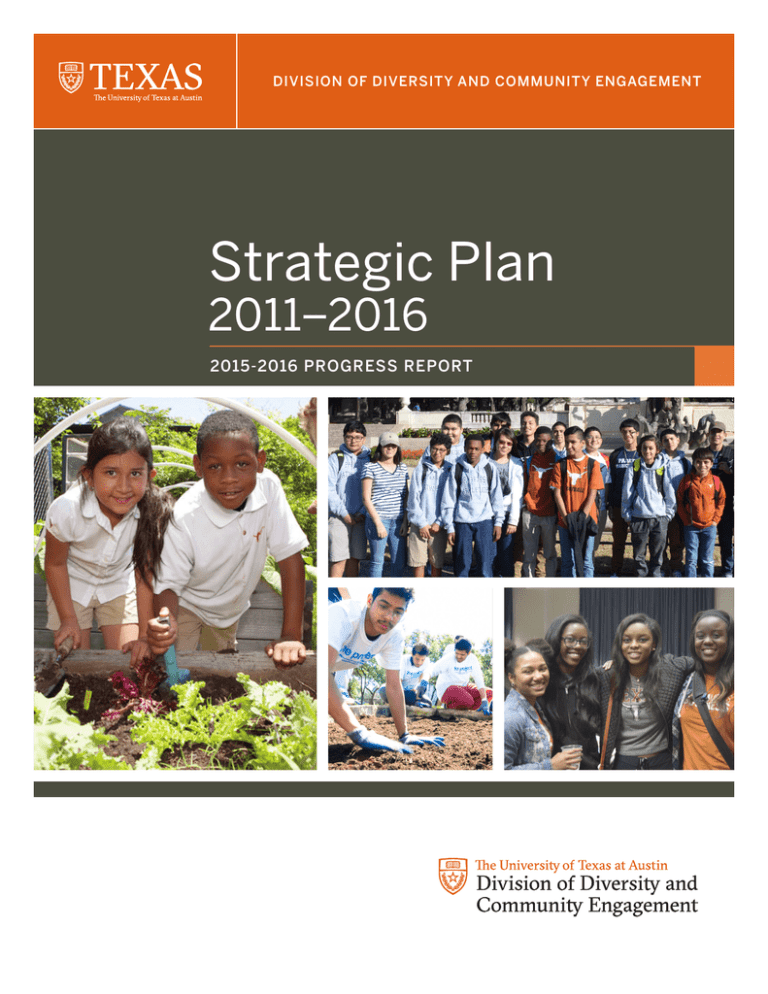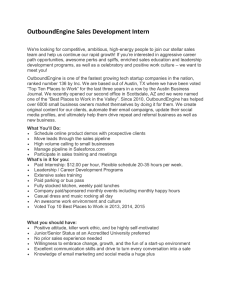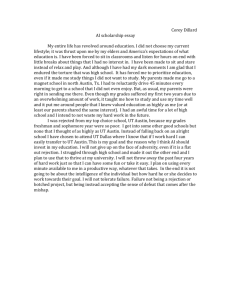Read the 2015-16 Progress Report
advertisement

DIVISION OF DIVERSITY AND COMMUNITY ENGAGEMENT Strategic Plan 2011–2016 2015-2016 PROGRESS REPORT Strategic Plan 2011–2016: 2015-2016 Progress Report DIVISION OF DIVERSITY AND COMMUNITY ENGAGEMENT • THE UNIVERSITY OF TEXAS AT AUSTIN “2016 marks the end of our ambitious five-year strategic plan. In looking back on our many accomplishments over the past five years, I am amazed at all we have done. Together we continue to foster a culture of excellence through diverse people, ideas, and perspectives. As we close this chapter, we now look to the future to build on the national standard we have set for what academic diversity and community engagement looks like in higher education.” Dr. Gregory J. Vincent Vice President for Diversity and Community Engagement Mission Vision The Division of Diversity and Community Engagement advances socially just learning and working environments that foster a culture of excellence through diverse people, ideas, and perspectives. We engage in dynamic community-university partnerships designed to transform our lives. The Division of Diversity and Community Engagement, as a national model, will strengthen the university’s academic and engagement mission by fostering a culture of excellence and social justice for the success of students, faculty, staff, alumni, and the community. Value Statements Year 4 Highlights: BY THE NUMBERS Diversity: Demonstrating respect for all individuals and valuing each perspective and experience. • R ecord number admissions applications from African American and Hispanic students—an 18% and 20% increase, respectively, from previous year Community Engagement: Learning and working collaboratively with community members and organizations to achieve positive change. • 1 18 teaching assistants and assistant instructors from 45 academic departments Inclusion: Breaking down barriers to meaningful participation and fostering a sense of belonging. Integrity: Setting high standards of professional ethics and being consistent in principles, expectations, and actions. Leadership: Guiding and inspiring people and organizations toward excellence. Partnerships: Cultivating mutually beneficial internal and external relationships built upon trust, cooperation, and shared responsibility. Social Justice: Challenging injustice and working toward an equitable society in which all enjoy equal rights and opportunities. •7 5% of Longhorns volunteered 1 million hours—an average of approximately $22 million in economic impact for the communities we serve participated in Inclusive Classrooms Leadership Certificate Seminars • 20+ DDCE representatives presented original research at American Education Research Association and the Association for the Study of Higher Education meetings • 14,000+ pre-college students served within the Longhorn Center for School Partnerships •3 00 community partners, including non-profit organizations, school districts, and pipeline initiatives • 118 bias incident reports managed by the Campus Climate Response Team • 100+ people attended Peers for Pride performance where Gender and Sexuality Center Peers for Pride Research Project findings were presented • 1 ,821 UT Austin students served in the Longhorn Center for Academic Excellence, including over 300 in Intellectual Entrepreneurship Program •8 3 external and internal events, including 20 signature and special community events coordinated by Community and External Relations • 53 different social justice educational opportunities coordinated by units represented on the Campus Culture Council • 1 9 bias response teams at institutions across the nation participated in the Bias Response Team Study 2 DDCE STRATEGIC PLAN • 2015-2016 PROGRESS REPORT inclusive culture engages people ideas vibrant dynamic working learning inclusion challenging injustice respect access belonging transform collective strength diversity CAMPUS CULTURE STRATEGIC GOAL Advance efforts to create an inclusive, accessible, and welcoming culture on campus. Campus Culture 2014–15 Highlighted Accomplishments 2015–16 Highlighted Priorities • Administered pilot of the social justice educational opportunities inventory with departments represented on the Campus Culture Council, which yielded documentation of 53 educational opportunities. • L everage staff expertise and UT Austin partnerships within DDCE’s new Office for Inclusion and Equity to develop a national model for creating and sustaining a more inclusive campus culture.* • Piloted the Student Social Justice Education Initiative, based out of the Multicultural Engagement Center, as an active and intentional cross-community building initiative for students. •D evelop new and updated content for at least two existing workforce training sessions offered by the Office for Inclusion and Equity to foster a culture of inclusion and accessibility.* • Facilitated 5 Inclusive Classrooms Leadership Certificate Seminars for teaching assistants and assistant instructors after piloting initial seminar in partnership with the Graduate School. • Advised College of Fine Arts Diversity Committee in implementing year-one priorities within its diversity plan’s curriculum and creative programming, recruitment and retention, and culture and climate goals. • Partnered with College of Natural Sciences associate dean for faculty affairs to implement inclusive recruitment best practices within college resulting in an increase of women and faculty of color interviewed and hired. • Collaborated with senior vice provost for faculty affairs to create campus-wide Council for Racial and Ethnic Equity and Diversity focused on recruiting, retaining, and advancing a racially and ethnically diverse faculty. •P rovide campus faculty and staff training and education related to diversity, equity, and social justice via the Diversity Education Initiatives Committee. •F acilitate faculty focus group to generate input and support for development of Inclusive Classrooms Faculty Leadership Seminar. •B roaden the Office for Inclusion and Equity’s faculty recruitment and retention initiatives through its work with the Council for Racial and Ethnic Equity and Diversity and partnerships with individual colleges and schools. • I nitiate the development of a Title VI/Nondiscrimination Plan, which considers education, outreach, compliance, data collection and analysis, and language access.* *Denotes multi-year priority activity 2015-2016 PROGRESS REPORT • DDCE STRATEGIC PLAN 3 partnership cultivate enrich resources ideas unite create connect history learning plan potential community synergy success change opportunity build future service social COMMUNITY ENGAGEMENT STRATEGIC GOAL Cultivate mutually beneficial community-university partnerships that further the mission of the university to serve Texas and beyond with an emphasis on historically and currently underserved communities. Community Engagement 2014–15 Highlighted Accomplishments 2015–16 Highlighted Priorities •R eceived ten-year Carnegie Foundation for the Advancement of Teaching Community Engagement Classification documenting UT Austin’s activities around community engagement and public service. •C onvene Community Engagement Portal Workgroup to discuss Digital Experience Project Plan online overhaul including reviewing and further developing the community engagement core site structure.* •P articipated in new UT Austin website launch while continuing to develop community engagement web portal design and its supporting mechanisms through collaboration with University Communications staff. •W ork with University Communications to develop a portal communications plan for execution via campus-wide communications representatives once site framework and structure are confirmed.* •C ontinued to establish guidelines for partnership and sponsorship stewardship system that best measures effectiveness of agreements and roles of individual units. •R eceive all four President’s Higher Education Community Service Honor Roll category recognitions, which highlight UT Austin’s role in solving community problems and participating in civic engagement via meaningful, measurable community outcomes.* • I mplemented DDCE Austin Community Advisory Council evaluation of partnership stewardship which informed the Community Engagement Plan, designed to improve community access to university resources. •C onvened Community Engagement Taskforce for President’s Higher Education Community Service Honor Roll, recognizing UT Austin’s role in solving community problems and participating in civic engagement via meaningful and measurable outcomes. •C ontinued reaffirmation of commitment to repair fragmented relationships with historically and currently underserved communities via community events and division-wide initiatives, programs, and platforms. •U tilize Community Engagement Taskforce to update partnership and sponsorship inventory, stewardship definitions, and division-wide MOU agreements to include in Community Engagement Plan.* •C ontinue to develop communication platforms including Mission Moments, Community Compass, and publications as part of community relations initiatives to be included in Community Engagement Plan. •A ssess feedback from DDCE Austin Community Advisory Council survey to determine direction for community relations programs to be included in Community Engagement Plan. *Denotes multi-year priority activity 4 DDCE STRATEGIC PLAN • 2015-2016 PROGRESS REPORT pathways culture engages people ideas educate college learning working programs progress student diversity success belonging transform strength community align EDUCATION PIPELINE STRATEGIC GOAL Create a successful pathway for first-generation and underrepresented students as they progress from pre-K through graduate and professional school. Education Pipeline 2014–15 Highlighted Accomplishments 2015–16 Highlighted Priorities •R eceived multi-year grant from Law School Admission Council to create DiscoverLaw.org PLUS, a partnership between Huston-Tillotson, UT Law, and DDCE. (Inaugural session held during summer 2015) •E xpand the Pipeline Council to include representatives from across Academic Diversity Initiatives (ADI) units and increase attendance at council meetings. •C onducted strategic meetings with deans and associate deans of all colleges across UT Austin’s campus to coordinate services that impact students, including the sharing of student performance data. •L aunched collaboration between pre-college units and Admissions to promote Texas Advance, a scholarship initiative supporting “hard-working, economically disadvantaged” high school students in Texas. •U pdated recruitment/retention plan during retreats and emphasized expanding Academic Diversity Initiatives (ADI) partnerships to enhance collective impact of pipeline. •S tarted process of simplifying data collection methods and standardizing reported content across ADI units to provide fuller portrait of implementation of pipeline priorities. •D evelop time and cost effective methods for collecting feedback from partners for use in decision-making. •D etermine and build opportunities for student-focused internal ADI collaborations.* • I dentify and create opportunities for student-focused internal UT Austin collaborations, including a pre-college to college STEM pipeline.* • I nvestigate opportunities for creating student-focused programming centered on health sciences and identify potential collaborations within UT Austin and across relevant communities.* • I ncrease longitudinal tracking of students in education pipeline by continuing pilot of data management system in pre-college units and investigate scaling system across DDCE, including funding.* *Denotes multi-year priority activity 2015-2016 PROGRESS REPORT • DDCE STRATEGIC PLAN 5 knowledge inclusive culture people ideas vibrant dynamic teach create national model challenges innovation respect success policy best practices collective diversity strength RESEARCH & BEST PRACTICES STRATEGIC GOAL Serve as a national model for the creation of knowledge about and best practices for diversity and community engagement through innovative scholarship, teaching, policy development, programs, and services. Research & Best Practices 2014–15 Highlighted Accomplishments 2015–16 Highlighted Priorities •Worked in partnership with the Gender and Sexuality Center to develop a plan to disseminate findings from the Peers for Pride program research project and to establish a research process that will serve as a model for how the committee will work with other DDCE units. •Support data collection and analysis conducted within each DDCE unit and creation of research documents for audiences chosen by unit.* •Participated in the 2015 Peers for Pride (PfP) final performance and shared findings from their research PfP study, determining how participating in the Peers for Pride program impacted the lives of PfP facilitators. •Published in the book chapter “Exercising Agency in the Midst of Racial Battle Fatigue—A Case for Intragroup Diversity” in K. Varner, K. Albert, R. Mitchell & C. Allen (Eds.) book titled Racial Battle Fatigue: Difference and Division in Higher Education. •Research results from the Bias Response Team Study featured in The Chronicle of Higher Education (April 21, 2015). 6 DDCE STRATEGIC PLAN • 2015-2016 PROGRESS REPORT •Create database of potential internal and external outlets for research.* •Identify completed research within each DDCE unit.* •Identify audiences and outlets that research seeks to reach.* •Make efforts to align the resources stored in clearinghouse so that DDCE staff can easily utilize the data shared across all units.* *Denotes multi-year priority activity Implementation Committee The Division of Diversity and Community Engagement strategic planning process involved a variety of staff who served on design, steering, planning, and strategy teams. To facilitate the next phase of the strategic plan, Dr. Gregory J. Vincent appointed an Implementation Committee to set priorities, track progress toward achieving the division’s four strategic goals, and oversee the implementation of the goals aligned with their specific portfolios and units. 2014–15 Implementation Committee 2015–16 Implementation Committee co-chairs co-chairs Dr. Sherri L. Sanders Associate Vice President for Strategic Initiatives Erica Sáenz Associate Vice President for Community and External Relations Dr. Gregory J. Vincent Vice President for Diversity and Community Engagement Dr. Suchitra Gururaj Assistant Vice President and Executive Director, Longhorn Center for Community Engagement and Community Engagement Center members Ms. Katherine Antwi Green Institutional Equity Ms. Leslie Blair Community and External Relations Dr. Aileen Bumphus Academic Diversity Initiatives and Student Engagement Ms. Kim Carmichael University Interscholastic League Dr. Robiaun Charles Development Dr. Eric Dieter Academic Diversity Initiatives and Student Engagement Dr. Suchitra Gururaj Academic Diversity Initiatives and Student Engagement Mr. Simon Hughes Information Technology Services Dr. Jennifer Maedgen Equity and Access and Chief of Staff Dr. Octavio Martinez Hogg Foundation for Mental Health Dr. Ryan A. Miller Academic Diversity Initiatives and Student Engagement Mr. Jason Molin Community and External Relations Dr. Leonard Moore Academic Diversity Initiatives and Student Engagement Mr. Patrick Patterson Academic Diversity Initiatives and Student Engagement Ms. Ixchel Rosal Student Diversity Initiatives Ms. Erica Sáenz Community and External Relations Dr. Stella Smith Academic Diversity Initiatives and Student Engagement Dr. Betty Jeanne Taylor Strategic Initiatives Dr. Ryan A. Miller Director, Office for Inclusion and Equity Dr. Gregory J. Vincent Vice President for Diversity and Community Engagement members Ms. Leslie Blair Community and External Relations Dr. Aileen Bumphus Academic Diversity Initiatives and Student Engagement Ms. Tatiana Calliham DDCE Finance Ms. Kim Carmichael University Interscholastic League Dr. Eric Dieter Academic Diversity Initiatives and Student Engagement Mr. Simon Hughes Information Technology Services Dr. Darren Kelly Academic Diversity Initiatives and Student Engagement Dr. Jennifer Maedgen Equity and Access and Chief of Staff Dr. Octavio Martinez Hogg Foundation for Mental Health Mr. Jason Molin Community and External Relations Dr. Leonard Moore Academic Diversity Initiatives and Student Engagement Mr. Patrick Patterson Academic Diversity Initiatives and Student Engagement Mr. Gregory Perrin Development Ms. Ixchel Rosal Student Diversity Initiatives Dr. Stella Smith Academic Diversity Initiatives and Student Engagement Ms. Helen Wormington Office of the Vice President 2015-2016 PROGRESS REPORT • DDCE STRATEGIC PLAN 7 STRATEGIC GOALS from the DDCE Strategic Plan 2011–2016 CAMPUS CULTURE COMMUNITY ENGAGEMENT EDUCATION PIPELINE RESEARCH & BEST PRACTICES Advance efforts to create an inclusive, accessible, and welcoming culture on campus. Cultivate mutually beneficial community-university partnerships that further the mission of the university to serve Texas and beyond with an emphasis on historically and currently underserved communities. Create a successful pathway for first-generation and underrepresented students as they progress from pre-K through graduate and professional school. Serve as a national model for the creation of knowledge about and best practices for diversity and community engagement through innovative scholarship, teaching, policy development, programs, and services. For More Information contact: Erica Sáenz Associate Vice President for Community and External Relations ericasaenz@austin.utexas.edu Dr. Suchitra Gururaj Dr. Ryan A. Miller Assistant Vice President and Executive Director, Longhorn Center for Community Engagement and Community Engagement Center Director, Office for Inclusion and Equity rmiller@austin.utexas.edu suchi.gururaj@austin.utexas.edu online: Access all DDCE Strategic Plan documents at http://ddce.utexas.edu/2016 MARCH 2016 Division of Diversity and Community Engagement The University of Texas at Austin 110 Inner Campus Drive, Stop G1050 Austin, Texas 78712 • (512) 471-3212

